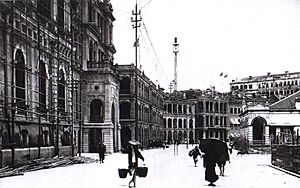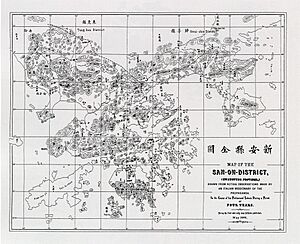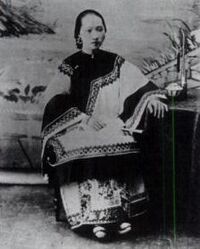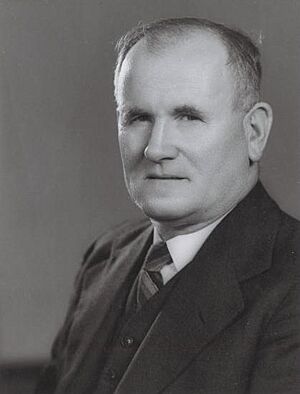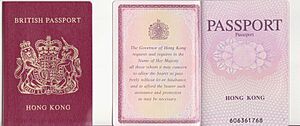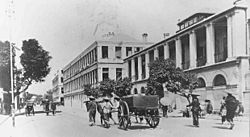History of Hong Kong (1800s–1930s) facts for kids
Hong Kong (1800s–1930s) was a time when the new crown colony of Hong Kong was founded under the British Empire. After the First Opium War, the land was given by the Qing Empire to the United Kingdom of Great Britain and Ireland forever through the Treaty of Nanjing (1842) and the Convention of Peking (1860). More land was also leased to the British in 1898 under the Convention for the Extension of Hong Kong Territory. This made Hong Kong one of the first places in East Asia to become industrialized.
Contents
How Hong Kong Became a British Territory
Early Trade with China
China was the main supplier of tea to the British. By 1830, people in Britain drank about 30 million pounds of tea each year. This was about 1 pound of tea per person.
Chinese tea was very important for the British economy. It made a lot of money for foreign businessmen in China, called taipans. The tax on tea also made up 10% of the British government's income. At first, the British sold things like clocks, watches, and musical boxes to China to trade for tea. However, this was not enough. China also wanted to be paid in silver. After 1830, Britain started selling Opium from India to China to get the silver they needed.
In 1839, Lin Zexu, a special Chinese official, wrote a letter to Queen Victoria. He was against the opium trade. He took over 20,000 chests of opium in Hong Kong, which was a transfer point, and destroyed them.
The Opium Wars and Land Acquisition
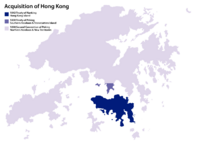
London saw the destruction of British goods as an insult. They sent their first military force to the region. The First Opium War (1839–1842) began. British forces, led by Captain Charles Elliot and Captain Anthony Blaxland Stransham, fought against China. After several Chinese defeats, Hong Kong Island was taken by the British on January 20, 1841. Sir Edward Belcher landed in Hong Kong on January 25, 1841. Possession Street still exists today to mark this event. Commodore Sir Gordon Bremer raised the Union Jack flag and claimed Hong Kong as a colony on January 26, 1841.
The island was first used as a stop during the war. Even though the British East India Company wanted a permanent base on Zhoushan island, Captain Elliot decided to claim Hong Kong Island permanently. Hong Kong Island was officially given to Britain in 1842 under the Treaty of Nanking. It then became a Crown colony.
The Opium War was fought to open up trade with China. With a base in Hong Kong, British traders started a city that would become a major "free trade" center in the East. American traders soon joined this trade.
In 1860, the Convention of Peking ended the Second Opium War (1856–1858). Britain gained the area south of Boundary Street on the Kowloon Peninsula. This land was leased forever without rent. Later, in 1898, the Qing government agreed to the Convention between Great Britain and China Respecting an Extension of Hong Kong Territory. This agreement forced China to give more land north of Boundary Street, up to the Sham Chun River, along with over two hundred nearby islands. The British government saw these areas as important for defending Hong Kong. They became known as the New Territories. This 99-year lease would end at midnight on June 30, 1997.
People and Society
Population Growth
When the British flag was raised over Possession Point on January 26, 1841, about 6,000 people lived on Hong Kong Island. Most were Tanka fishermen and Hakka charcoal burners living in small villages. In the 1850s, many Chinese people moved from China to Hong Kong because of the Taiping Rebellion. Other problems like floods, typhoons, and famine in mainland China also made Hong Kong a safe place to escape to.
By 1865, Hong Kong had a population of 125,504 people. About 2,000 of them were Americans and Europeans. In 1914, 60,000 Chinese people left Hong Kong because they feared an attack during World War I. However, Hong Kong's population still grew. It went from 530,000 in 1916 to 725,000 in 1925, and reached 1.6 million by 1941.
Social Differences
Hong Kong became a major trading center from the start. It attracted people from China and Europe. However, society remained divided by race due to British colonial rules. Even though a Chinese upper class, educated in Britain, grew by the late 1800s, laws like the Peak Reservation Ordinance stopped Chinese people from living in rich areas like Victoria Peak.
Politically, the majority Chinese population had little to no official power in the early years. But there were a few Chinese leaders the British governors relied on. These included Sir Kai Ho and Robert Hotung. They accepted their place in Hong Kong's society. They acted as important links between the government and the Chinese people. Sir Kai Ho was an unofficial member of the Legislative Council. Robert Hotung wanted Chinese citizens to see Hong Kong as their new home after the fall of China's last dynasty in 1911. As a rich millionaire, he stressed that no group of people in Hong Kong was purely native to the land.
Daily Life and Culture
How People Lived

The eastern part of Colonial Hong Kong was mostly for the British. It had race courses, parade grounds, army barracks, and fields for cricket and polo. The western part was full of Chinese shops, busy markets, and tea houses. The Hong Kong tea culture started during this time and grew into yum cha. A common breakfast was congee with fish and barley.
In the mid-1800s, many merchants sold silk and jade. They also used feng shui to set up their shops for good luck. Other groups, like coolies, came hoping that hard work would lead to a better future. Because of the success of merchants, boatmen, and fishermen, Hong Kong became more important than China's busiest port in Canton. By 1880, Hong Kong's port handled 27% of mainland China's exports and 37% of its imports.
A British traveler, Isabella Bird, described Hong Kong in the 1870s as a colony with many comforts and entertainment. These were things only a Victorian society could enjoy. Other descriptions mentioned courts, hotels, post offices, shops, city halls, museums, and libraries. Many European businessmen came to Hong Kong for trade. They were called tai-pans or "bigshots." A popular place for tai-pans was the Hong Kong Club on Queen's Road.
Education System
In 1861, Frederick Stewart helped create Hong Kong's education system. He brought Western-style teaching to the East. Some people believe his work was a key moment. It helped a group of Chinese people modernize Hong Kong, unlike those in mainland China. This education brought Western ideas about finance, science, history, and technology into the culture. The father of modern China, Sun Yat-sen, also studied in Hong Kong at Central School.
Law and Order
In 1843, the legislative council was set up. The governor of Hong Kong often acted as the British representative in the Far East in the early years. The Colonial Secretary also helped with legal matters.
A colonial police force was created in the 1840s to deal with the high crime rate in Hong Kong. Crime at sea was common, as some pirates had weapons like cutlasses and revolvers. Court hearings for criminal and sea-related cases began on March 4, 1844. They were overseen by the first governor, Lieutenant General Sir Henry Pottinger, and Lieutenant-governor George D'Aguilar.
Health Challenges and Disasters
The Third Pandemic of bubonic plague started in China in the 1880s. By the spring of 1894, about 100,000 people had died on the mainland. In May 1894, the disease spread to Hong Kong's crowded Chinese area of Tai Ping Shan. By the end of that month, about 450 people had died from the illness. At its worst, the plague was killing 100 people a day. It killed a total of 2,552 people that year. The disease greatly harmed trade and caused 100,000 Chinese people to temporarily leave the colony. The plague continued to be a problem in Hong Kong for the next 30 years.
In the 1870s, a strong typhoon hit Hong Kong one evening. It was strongest around midnight. About 2,000 people lost their lives in just six hours.
Economy and Development
Transportation
The growth of Hong Kong relied a lot on moving people and goods across Victoria Harbour. The creation of the Star Ferry and the Yaumati Ferry was very important. In 1843, the colony built its first ship at a private shipyard. Later customers included the Spanish government in the Philippines and the Chinese navy.
The Peak Tram started in 1888, and the Tramway service began in 1904. The first railway line, the Kowloon-Canton Railway, opened in 1910.
On land, rickshaws became very popular when they arrived from Japan in 1874. They were cheap and useful for street merchants to carry goods. Sedan chairs were preferred by wealthy Europeans living on Victoria Peak. This was because the hills were too steep for rickshaws until the Peak Tram was built. The first cars in Hong Kong, powered by petrol, arrived between 1903 and 1905. At first, people did not like them much. Cars only started to become popular around 1910. Most car owners were British. Buses run by different companies grew in the 1920s. In 1933, the government officially gave licenses to the China Motor Bus and Kowloon Motor Bus companies.
Flying boats were the first British airplanes to reach Hong Kong in 1928. By 1924, Kai Tak Airport was also founded. The first flight service from Imperial Airways became available in 1937. A ticket cost 288 pounds.
Hospitals and Hotels
Soon after the British took Hong Kong in 1841, Protestant and Catholic missionaries began offering social services. Italian missionaries started providing education for boys in 1843. "The Catholic French Sisters of St. Paul de Chartres" opened one of the first orphanages and elderly homes in 1848.
In 1870, the Tung Wah Hospital became Hong Kong's first official hospital. It provided many social services and offered free vaccinations in Hong Kong Island and Kwang Tung. After raising money for the 1877 famine in China, some hospital officials became powerful leaders. They represented the Chinese majority.
Some of the popular hotels of that time included the Victoria Hotel, New Victoria Hotel, and the King Edward Hotel.
Financial Growth
In 1864, the first large modern bank, Hong Kong Shanghai Bank, was established. This made Hong Kong a key financial center in Asia. Its chief manager, Sir Thomas Jackson, has a statue in Statue Square. The bank first rented Wardley House for HKD 500 a month in 1864. After raising HKD 5 million, the bank opened in 1865. The Association of Stockbrokers was also created in 1891.
Resources and Companies
In December 1890, the Hongkong Electric company started producing electricity with help from Catchick Paul Chater. This was the first step in changing from gas lamps to light bulbs. Other companies, like Jardine Matheson, launched the "Hong Kong Land Investment and Agency company Ltd." This company gained as much wealth as the entire government's income.
Politics and Governance
One person described these decades as full of "politics, propaganda, panic, rumor, riot, revolution, and refugees." Hong Kong became a safe place for Chinese political refugees. Few serious attempts were made to take it back in the early 1900s. Both Chinese Communist and Nationalist activists found safety in Hong Kong.
However, the dockworkers' strikes in the 1920s and 1930s were often blamed on the Communists by the authorities. This caused a strong reaction against them. A strike in 1920 ended with a wage increase of HKD 32 cents.
Ambrose King, in his 1975 paper Administrative Absorption of Politics in Hong Kong, described Hong Kong's colonial government as "elite consensual government." He said that any powerful group that could challenge the government would be brought into the system. This was done by appointing leading activists, business figures, and other important people to committees. They were also given British honors and invited into elite groups like Hong Kong's horse racing clubs. He called this "synarchy".
When modern China began after the fall of the last dynasty, one of the first political changes in Hong Kong was the immediate switch from long queue hairstyles to short haircuts. In 1938, Guangzhou fell to the Japanese. Hong Kong was then seen as an important military outpost for all trade in the Far East. Even though Winston Churchill said Hong Kong was an "unbeatable fortress," it was a reality check. The British Army was spread too thin to fight on two fronts.
See also
 In Spanish: Historia de Hong Kong colonial para niños
In Spanish: Historia de Hong Kong colonial para niños
- Thirteen Factories
- The Hongs
- Tai-Pan (novel)
- Hong Kong Royal Instructions
- Hong Kong Letters Patent


